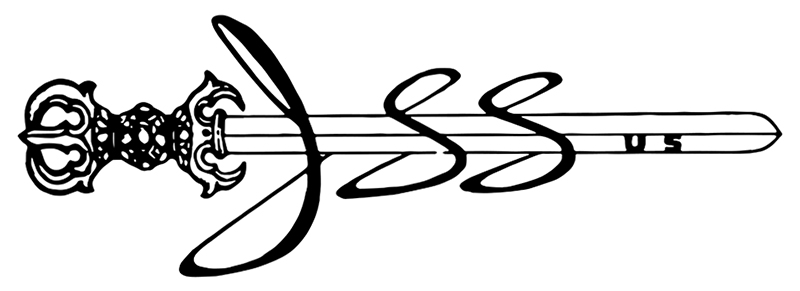
The articles on this page originally appeared in JSSUS newsletter Volume 48 no.3 2016.
EXPLORING THE TATAMI - GUSOKU CHOCHIN KABUTO
(The folding armor collapsible helmet ) by Robert Earhart Page 17
Copyright 2016 Japanese Sword Society of the United States
EXPLORING THE TATAMI - GUSOKU CHOCHIN KABUTO
(The folding armor collapsible helmet )Robert Earhart
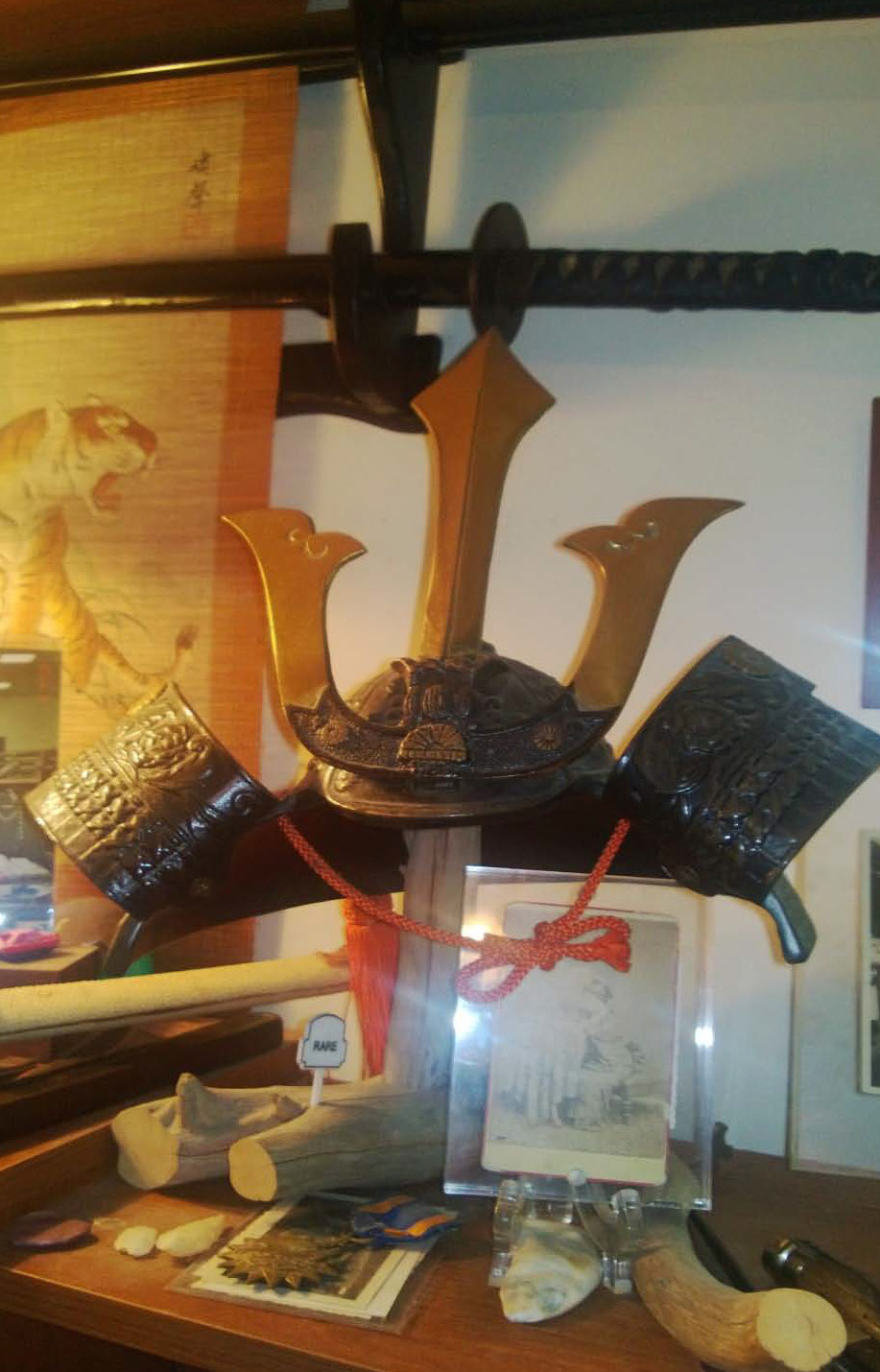
One of the great strengths that illustrate the Japanese genius for industry has been her ability to assimilate essential items, and then redesign them through practical experience into end products that function better than the items originally fed into the system.
From the standpoint of the collector and connoisseur, this process has been accomplished while maintaining, if not perfecting the untainted essence of character that defines Japanese art aesthetic. Nowhere, it seems in the global scale has this been more accepted than in the appreciation of Japanese arms and armor from the late Heian art period (1156) to the period of the restoration of Mutsuhito to the ancient seat of power in the year 1868. (Mejia)
Focusing on the realm of armor and kabuto, in this exploration we find various metallic/leather plate styles depicted on hani-wa clay figures excavated in Kofun period burial tombs dating to the seventh and eighth centuries.
As the Saburai (“One who serves ") caste began to emerge and mature after the first millennium, societal social development, patterns of settlement and
resultant economic pressures caused styles of warfare and individual combat to change over a period of years. To keep pace with the changes in this demographic of Japanese warfare, sword and armor physical shapes and design also changed. Many collector / connoisseur's feel that a zenith was reached in the late Heian and early Kamakura periods for both swords and armor in quality of style and design.
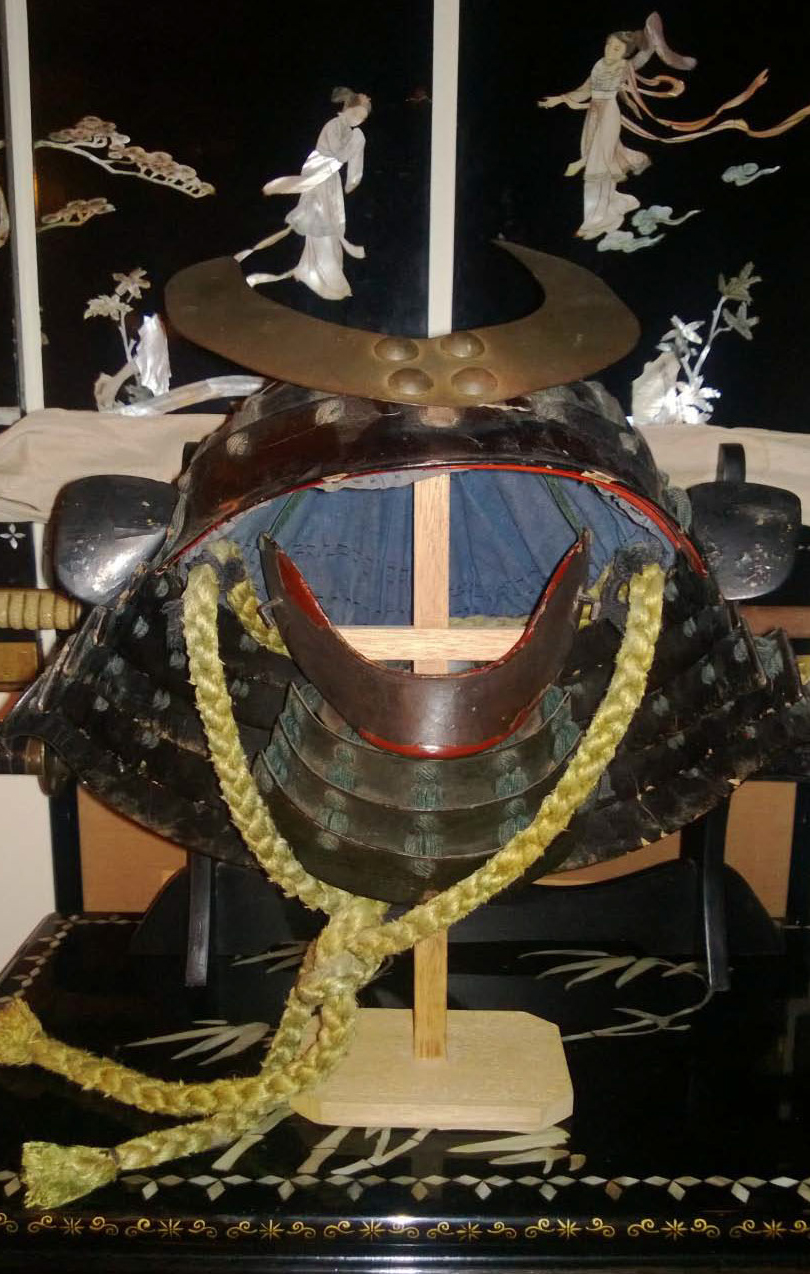
This classic style type (here represented with a very heavy, Taisho era, one half size bronze ) exhibits the appreciated features of a long downward sweeping shikoro, complete with elaborate color combination hishi nui cross knots on the lower lamelle and a rounded daienzan hachi ( helmet bowl ) with a classic, very prominent kuwagata incorporating the blade of a Buddhist ken. [For you collectors, as an aside, this is an uncommon bronze not to be confused with kabuto for some of the earlier Boys Day armors. I have only encountered three examples in the last 50 years and one of these was located in Japan.
These bronzes are very heavy, very accurate four piece constructions and represent the top award for Naval Officer competitions held across Japan. Very few were
awarded, and consequently even fewer came to the United States through the U.S. Army of Occupation after World War Two. If you get the opportunity, an example can be a very valuable addition to the collection. This specimen has the touch mark of the foundry that produced it, on the inside of the helmet, finished in dome relief reminiscent of an old armorer's signature. It was originally boxed with a sliding hinoki wood front cover with inscription. Complete with helmet ties, it is very cool!
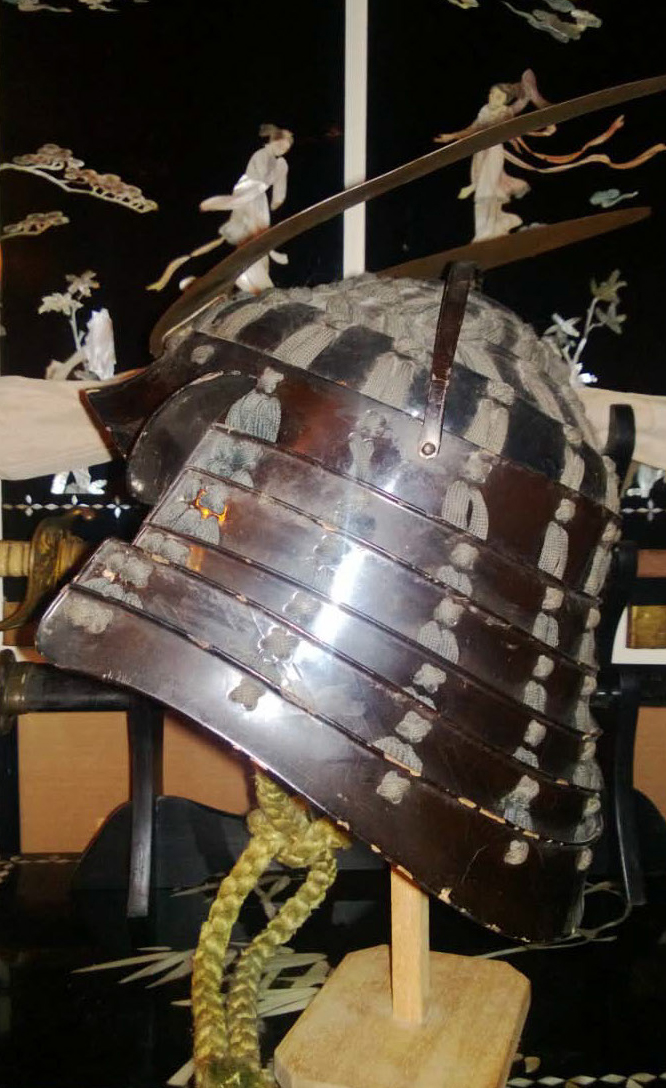
We know that changes in combat led over time to modifications in classic armor and sword types. Passing through the Nambokucho era into the period of the Sengoku, we see that in many cases, armors became lighter in weight, and generally more flexible, to adapt to these constantly changing conditions of combat.
On our subject example we see that the fukigaeshi ( shikoro turnbacks ) still function as protective shields to the odoshi ( helmet lacing ), but have become smaller and lighter weight.
The helmet has become much closer fitting to the head, with the lamelle sweep becoming very dramatic down the back side of the kabuto to provide additional protection to the rear of the neck area. The lamelle of the shikoro, it is noted, still maintain, if not elaborate, at least the dramatic sweeps of aesthetic styles originated in Heian and early Kamakura / Nambokucho art periods.
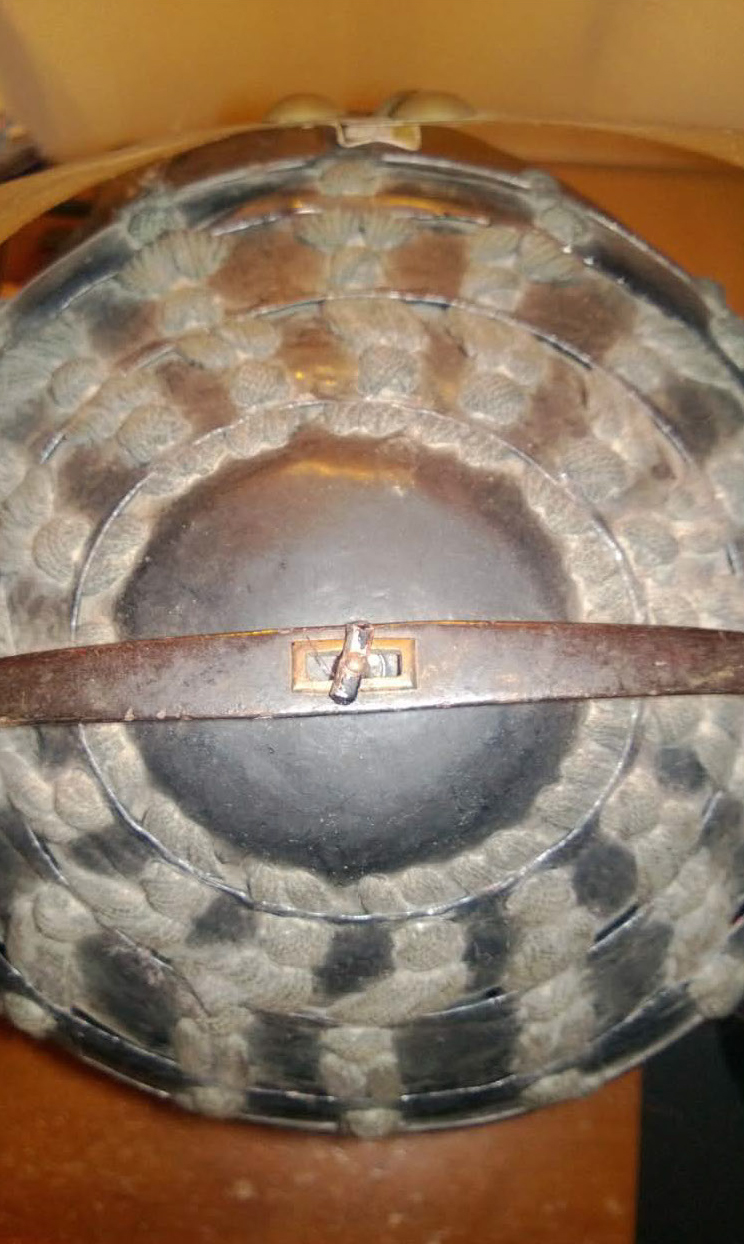
Viewed from the dorsal position, you can see that the formal ridges on the top of each shikoro lamelle form an interlocking reinforced protection against lace cutting. Also a natural constriction located at the koshi maki (lower edge of the hatchi or helmet bowl ) forms a protective niche behind which rests the kabuto no O ( helmet tie ). The feature of protecting the main helmet tie with a constriction where nothing exists except the double resistance of armor at the top and bottom of a sword strike is uniquely Japanese in its aesthetic style. This is a defining aesthetic in the attractiveness of this particular helmet type and may originate in the very
non ductile nature representing the cutting edge of the Japanese sword. Again it is to be noted, generally the edges of swords in this period were not razor sharp. Edge geometry of that type was considered to cut armor better than a more fragile razor edge style. Please do not think that this type of sword edge was any way near dull however, because given the wider widths from mune to ha, defining sugata in swords forged from this period, these blades are fully capable of completely cleaving bone and flesh. It was merely a difference in the geometry of the ha, governed by a functional requirement inherent in the popular style of warfare defining that period.
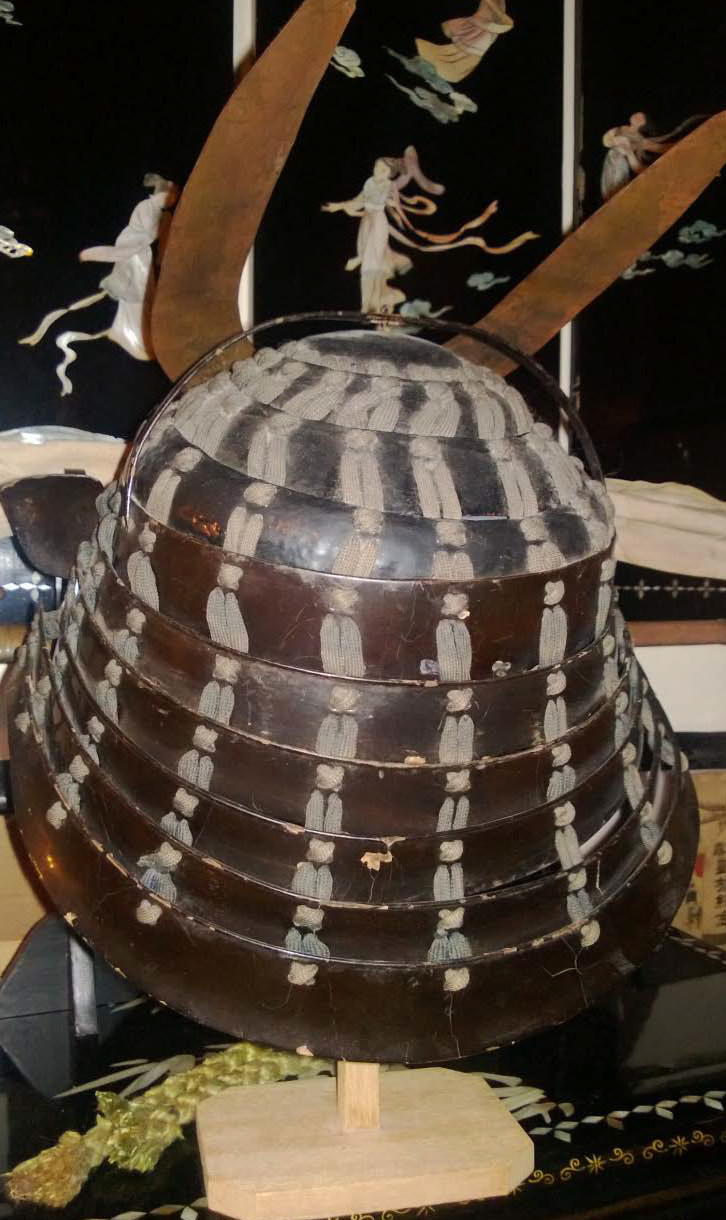
Considering now the crux of this exploration, and what sets this kabuto style apart as a particular example of Japanese genius for industry; we can view the major features which set this helmet apart as a developmental style which may very well represent the pinnacle of helmet design derived from Heian / Kamakura aesthetic lines, tempered by the no nonsense requirements of the Sengoku.
This rare Samurai officer’s grade helmet has the ability to be transformed into an extremely compact, easily transportable form via a very innovative, yet simplistic catch and hoop arrangement that locks the helmet into position.
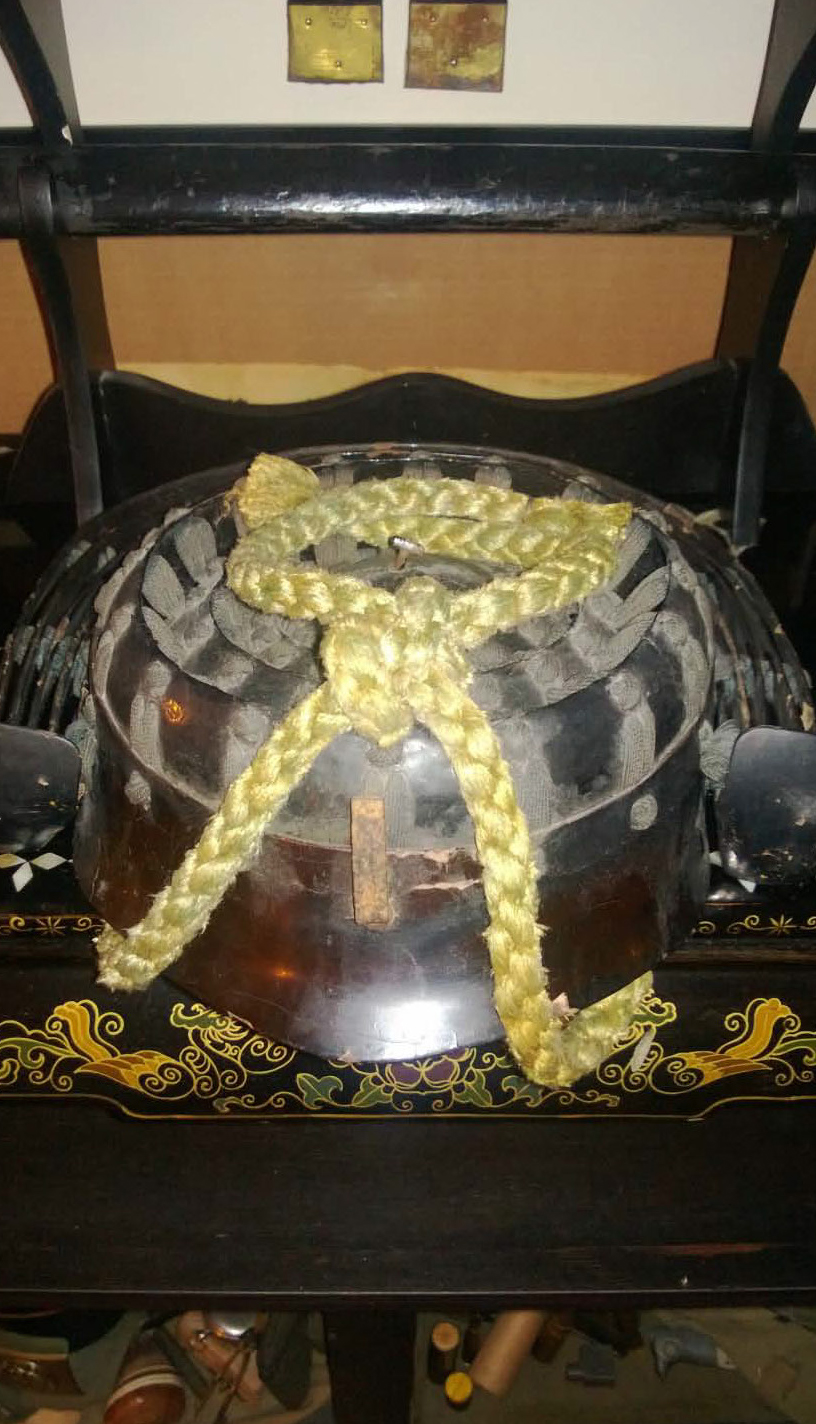
This design feature is unique when you see that the hoop is actually a piece of high carbon steel that has been hardened in the forge and then tempered back to the consistency of a spring. It is this spring tension combined with the overlapping hand tuned fit of the lamelle, that form the protective rigidity of the hachi (helmet bowl). These hoop features on various examples, can assume complex and
somewhat decorative forms.
The hoop itself may be constructed of two separate pieces, with dual locking catches, one each side of individual helmets. Also the hoop may be positioned to run in one piece, front and back across the hachi (bowl) and have a somewhat elevated, tempered metallic, urushi coated crest that is one piece with the design feature of the hoop. This crest will resemble the fins of an unagi (fresh water eel ) the idea being, if you catch an unagi , because of its skin, you cannot hold it firmly in your hands for very long to kill it.
The locking feature is just as ingenious in form following function, while preserving a definable Samurai art aesthetic. The locking catch is hidden behind the arms of the maedate (frontal crest ). This is the perfect place for it; on the apex of the mabizashi (helmet peak) ; as the wearer wouldn't want to expose it while receiving a sword strike.
The rectangular opening at the top of the spring tempered hoop has a kinko (soft metal) lining. Also the dual lower axel pivots and the rotating lock piece of the catch are overlain with a relatively thick layer of kinko material.
This is a brilliant solution to a complex design requirement, given the base materials of the helmet construction and a campaign environment that was lacking in petroleum and/or animal and plant based lubricants.
Armor was worn constantly while on campaign during the Sengoku, in all types of weather temperatures, with extended periods of rain and snow.
Soft metal alloys are somewhat "oily" when rubbed together and do not corrode or bind the same way black iron does, particularly when traces of gold or percentages of silver are parent components of the product alloy ( shibuichi ). Hereditary craftsman were so competent in the purveyance of their craft specialty that they had over a period of generations worked out alloy component percentages that allowed the product alloy to take on different degrees of wear resistance depending on the application.
Evidence more than suggests this is what we are looking at on this particular subject example. While the catch is somewhat worn, due to finger pressure, acid residue, and extended exposure to weather and sunlight, the catch and lock still operates as it was designed originally. This helmet dates into the 1500's and that is
something on the lines of four hundred years. This is truly remarkable, even given the Japanese respect for the veneration of their arms and armor.
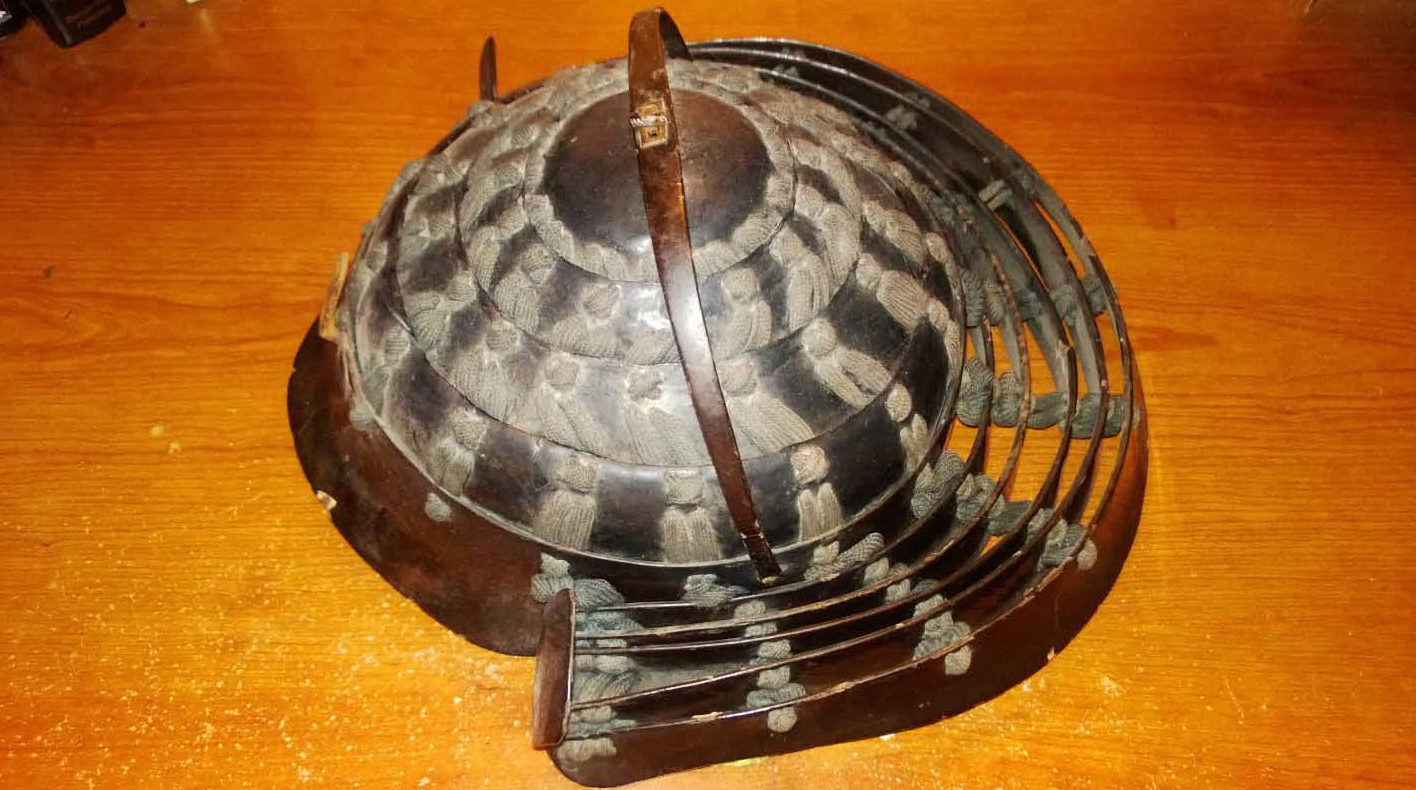
Releasing the lock and detaching the catch lets the hoop pivot to the dorsal side of the helmet, allowing the hatchi (bowl) to fold in upon itself much like a Japanese folding lantern.
The helmet then becomes a compact, transportable form about the size and shape of a dinner plate. It was placed in a protective covering, similar to a sword bag, but shaped like the folded kabuto, and was often boxed. With the silk shinobi no o (helmet cord) placed carefully on top of the collapsed hachi (bowl) to safely cushion the maedate ( front crest ), the kabuto is ready for next use.
This is a disciplined procedure which has allowed our subject example to survive in wonderful original shape now getting nigh into the 21st century.
Closing: we find value in what may actually be the ultimate expression of flexibility, ease of transport combined with functional effectiveness in an overall evolutionary line of kabuto development; all the while maintaining stylistic lines definable as the Art of the Samurai.
Acknowledgement:
Mr. Livio W. (Chuck) Cillo Darlington, Maryland
A consummate Japanese sword specialist, I would like to express my thanks to him for encouraging me in my studies of Japanese swords and armor, and making the opportunity possible to document this definitive example of Samurai art.